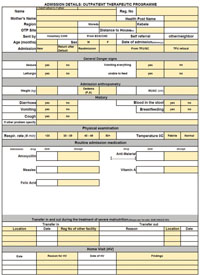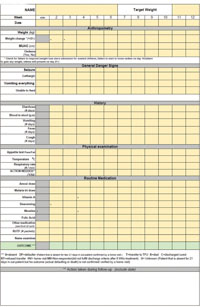10.5.2 The OTP card
The OTP card is a patient follow-up card that is used to help in your management of severe uncomplicated malnutrition. This card basically provides you with an opportunity to record information about children efficiently on a weekly basis. There is space for each key indicator to be filled out in an organised manner. Most of the front page of the OTP card is filled in on the date of admission. It provides relatively detailed information on the child’s identity, clinical history, physical examination, the anthropometric indicators warranting admission and also the medication given on the date of admission. You can see a copy of this part of the OTP card in Figure 10.4.
You can also see that low down on the front page there is space to write whether the child is transferred or not, and another space to write your findings in case you decide to do a home visit.
The back of an OTP card is dedicated to the weekly follow-up visits of children with severe uncomplicated malnutrition. There are twelve columns, representing one week each (see Figure 10.5).
Why won’t you be expected to manage children who are less than six months of age at your health post?
As you may remember, all children under six months old classified as having severe acute malnutrition have to be referred for in-patient care.
What is the maximum stay on OTP if a child does not reach the discharge criteria?
It is eight weeks, because if the child fails to reach the discharge criteria after this time they should be referred for in-patient care and detailed follow-up.
10.5.1 The registration book


